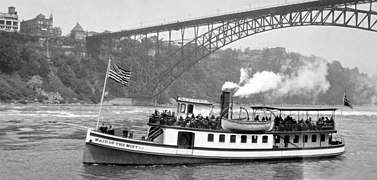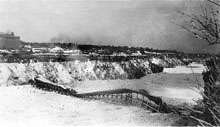Honeymoon Bridge (Niagara Falls)
The Upper Steel Arch Bridge, also known as the Honeymoon Bridge or Fallsview Bridge, was an international bridge which crossed the Niagara River, connecting Niagara Falls, Ontario, Canada, with Niagara Falls, New York, United States. It was located about 500 feet (150 m) upriver of the present-day Rainbow Bridge. It collapsed in 1938.
Upper Steel Arch Bridge Honeymoon Bridge | |
|---|---|
 The Upper Steel Arch Bridge at Niagara Falls | |
| Coordinates | 43°5′13.2″N 79°4′15.6″W |
| Crosses | Niagara River |
| Preceded by | Niagara Clifton Bridge |
| Followed by | Rainbow Bridge |
| Characteristics | |
| Design | Steel Arch Bridge |
| Total length | 1,240 ft (378 m)[1] |
| Longest span | 840 ft (256 m)[2] |
| History | |
| Construction end | 1897 |
| Opened | 1898 |
| Collapsed | January 1938 |
%26groups%3D_f71628b15e6a0067bd2db406d68d053150331040.svg)
| |
History
Built in 1897–98 by the Pencoyd Bridge Company, the Upper Steel Arch Bridge was located 14 ft (4.3 m) closer to the American Falls than the bridge that it replaced.[3] When completed, the bridge became the largest steel arch bridge in the world. Its features included a double track for trolley cars and room for carriages and pedestrians.[4] The bridge had to be constantly protected from ice bridges that formed over the river every winter. In January 1899 a huge ice bridge threatened the bridge when ice piled around its abutments due to their close proximity to the river's surface. The bridge was subsequently fortified with a 24-foot (7.3 m) tall stone wall around the abutments.[4]
The protection around the abutments held for about another forty years: until January 27, 1938, when the bridge collapsed. A sudden wind storm on Lake Erie sent a massive amount of ice over the falls, resulting in nearly 100 ft (30 m) of ice pushing against the bridge.[4] Final collapse occurred at 4:20 pm, before thousands of onlookers who had come to watch the bridge go. The structure collapsed in one piece into the river. Demolition of what was left of the bridge took place from February to April 1938 when all of the pieces were either removed or had sunk.[5] Construction of a replacement bridge was undertaken shortly thereafter, this time with the abutments much higher off the river. It was named the Rainbow Bridge and opened in November 1941.[4]
Gallery
.jpg) Upper Steel Arch Bridge from Goat Island, 1900
Upper Steel Arch Bridge from Goat Island, 1900.jpg) Curtiss Model D flies under Honeymoon Bridge, circa 1911
Curtiss Model D flies under Honeymoon Bridge, circa 1911 Maid of the Mist beneath Honeymoon Bridge, circa 1920
Maid of the Mist beneath Honeymoon Bridge, circa 1920 Collapsed bridge on ice jam in Niagara River (view from Canadian side)
Collapsed bridge on ice jam in Niagara River (view from Canadian side) Collapsed bridge (view from U.S. side)
Collapsed bridge (view from U.S. side) Closer view of collapse
Closer view of collapse
References
- Chisholm, Hugh, ed. (1911). . Encyclopædia Britannica. 19 (11th ed.). Cambridge University Press. p. 635.
- Honeymoon Bridge (Ontario) at Structurae
- "The Honeymoon Steel Arch Bridge". niagarafallsinfo.com. Retrieved 2014-12-15.
- "Fall Of The Honeymoon Bridge" (PDF). niagarafallsmuseums.ca. Retrieved 2014-12-15.
- "Collapse of the Honeymoon Bridge". www.niagarafrontier.com. Retrieved 2014-12-15.
External links
| Wikimedia Commons has media related to Honeymoon Bridge. |
- CBC Radio Archives Announcing the collapse of the bridge (1938)